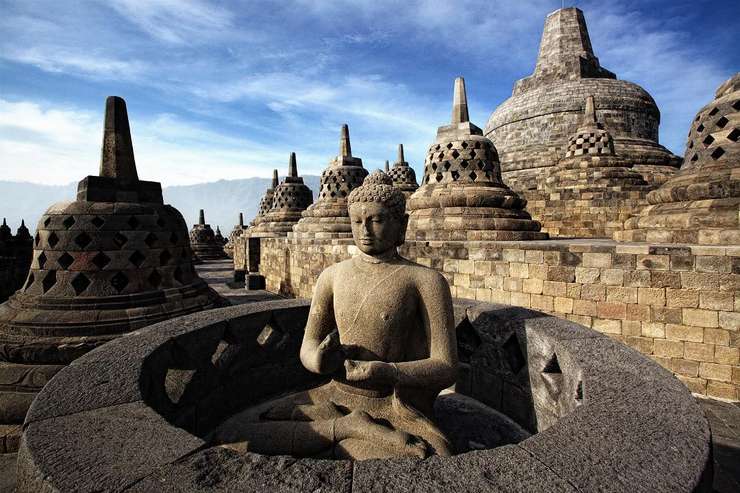More about Borobudur Temple
About Borobudur Temple
Borobudur Temple built in the 9th century during the reign of the Sailendra dynasty. This remarkable structure is adorned with intricate carvings and an awe-inspiring design, drawing visitors from across the globe. Its breathtaking architecture and rich heritage led to its designation as a UNESCO World Heritage Site in 1991.
Buried under layers of volcanic ash for centuries, Borobudur remained hidden until its rediscovery in 1814 by British governor Thomas Stamford Raffles. The temple underwent two major restoration efforts. First by Dutch archaeologists between 1907 and 1911, and a second, extensive project completed in 1983 to preserve its legacy.
The monument’s architectural style reflects influences from Indian Gupta and post-Gupta art, featuring a stepped pyramid structure that symbolises Buddhist cosmology. The temple consists of three symbolic levels, each representing a phase of the spiritual journey: kama-dhatu (realm of earthly desires), rupa-dhatu (realm of form), and arupa-dhatu (realm of formlessness). Built using volcanic stone, the structure spans nine terraces, culminating in a large central stupa, surrounded by 72 smaller bell-shaped stupas, many of which enshrine Buddha statues.
Pilgrims and visitors traditionally begin their journey at the eastern staircase, walking clockwise around each level before reaching the summit, covering over 5 kilometres in total. One of the temple’s most significant annual events is the Waicak ceremony, commemorating the birth, enlightenment, and passing of the Buddha. During this sacred event, thousands of saffron-robed monks gather at Borobudur in a solemn procession, reaffirming its importance as a spiritual and cultural landmark.
Borobudur Temple Opening Hours
The Borobudur Temple complex is open daily, with the ticket counter operating from 6:30 AM to 4:30 PM. Visitors can explore the temple grounds between 7:00 AM and 5:00 PM.
For a more immersive experience, sunrise visits are available from 4:30 AM to 6:00 AM, while sunset visits can be enjoyed from 5:00 PM to 6:30 PM. However, access to the main temple structure is only permitted Tuesday to Sunday, with entry slots every 30 minutes from 9:00 AM to 3:30 PM, and the final tour starting at 3:30 PM.
Borobudur Temple Tickets Prices and Types
Visitorscan choose between two ticket types to enter Borobudur Temple: Temple Ground Ticket, which grants access to the temple grounds, and Temple Structure Ticket, allowing visitors to climb to the top. Ticket prices vary for domestic and international tourists. While Borobudur Temple tickets are available on-site at the official counter, advance booking via Traveloka is recommended due to limited daily quotas.
Are There Any Upcoming Events at the Borobudur Temple?
Traditional dance performances are regularly held at Borobudur Temple throughout the year. One of the highlights is the Ramayana Ballet Prambanan, scheduled for April 2–10, 2025, and December 23–30, 2025. Another captivating show is the Roro Jonggrang Legendary Dance Drama, taking place on April 4 and 11, 2025, as well as December 24–31, 2025.
The grandest event at Borobudur is the Waisak (Vesak) Festival on May 13, 2025, commemorating the birth, enlightenment, and passing of Buddha. Thousands of pilgrims will gather to celebrate this significant occasion, making it a truly spiritual and cultural experience. Visitors who do not participate in the religious rituals can still experience the solemnity of the day by joining the Lantern Festival, held in the evening. To join, register online via the official link provided by organisers. Spots are limited, so early booking is advised. Event details may change yearly, so check official sources for updates.
What is Iconic about Borobudur Temple?
Borobudur’s renowned status comes from its remarkable architecture and deep spiritual meaning. Built from dark grey andesite stone, the temple features six square terraces beneath three circular platforms, intricately decorated with over 2,500 bas-relief panels and 504 Buddha statues. At its centre, a grand dome is encircled by 72 Buddha statues, each seated within a perforated stupa. This sacred design represents the journey to enlightenment, solidifying Borobudur as a revered pilgrimage site for Buddhists around the world.
Other Facilities in Borobudur Temple
The temple complex is equipped with various facilities to enhance visitor comfort, including restrooms, dining establishments, and souvenir shops.
Is Borobudur Temple Muslim-Friendly?
Yes, Borobudur Temple is Muslim-friendly. As a major tourist destination in Indonesia, it provides prayer facilities (mushola) near the temple grounds for Muslim visitors. Additionally, halal food options are available at nearby restaurants and food stalls.
What is The Nearest Stop for Public Transport to Borobudur Temple?
The nearest public transport stop to Borobudur Temple is Borobudur Bus Terminal. From there, visitors can continue their journey to the temple by becak (pedicab), dokar (horse-drawn cart), or on foot.
Is There Any Dress Code to Use When Visiting Borobudur Temple?
While there is no strict dress code enforced at Borobudur Temple, it is advisable to dress modestly out of respect for its religious significance. Wearing comfortable clothing and appropriate footwear is recommended, especially considering the warm and humid climate of Central Java.
Other Attraction That You Might Like
If you're interested in exploring more attractions that are similar like Borobudur Temple, consider visiting Prambanan Temple. Additionally, you can enhance your visit to Magelang by exploring Gereja Ayam Bukit Rhema or joining the VW Safari Borobudur Tour for a unique sightseeing experience.
Ready to book your Borobudur Temple Tickets? Just rely on Traveloka! With Traveloka, you can enjoy a seamless booking experience for any activities in Magelang and take advantage of amazing deals along the way. And don’t forget, booking attraction tickets is hassle-free with Traveloka, where you can also conveniently arrange your hotels and flight.











































 Facebook
Facebook Instagram
Instagram TikTok
TikTok Youtube
Youtube Telegram
Telegram
